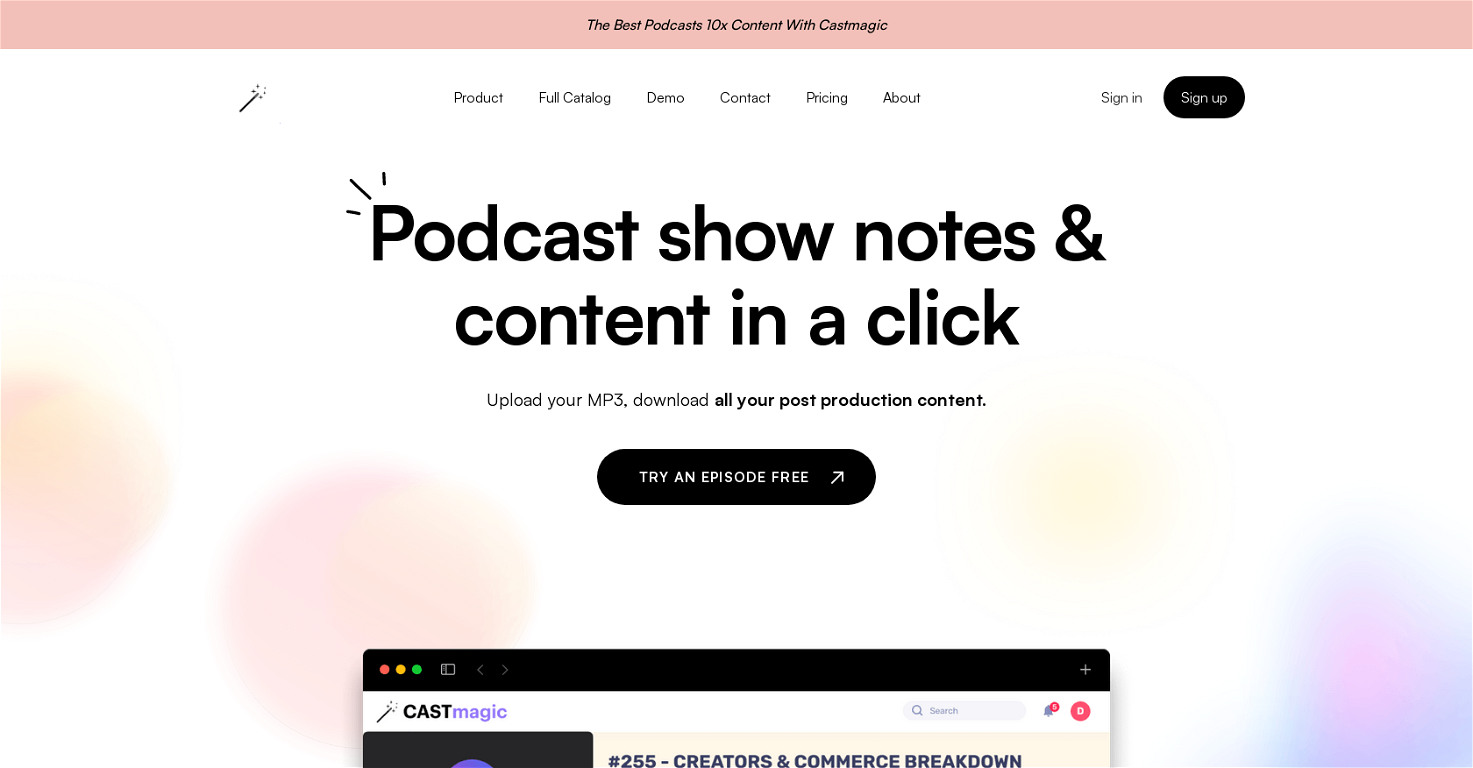
Castmagic: Complete Buyer's Guide
Comprehensive AI-powered content repurposing platform
Castmagic positions itself as a comprehensive AI-powered content repurposing platform designed specifically for transforming podcast recordings into multi-channel marketing assets. The platform serves the growing market of content teams seeking to automate the traditionally manual process of creating show notes, social media clips, and promotional materials from long-form audio content[121][131][133].
Market Position & Maturity
Market Standing
Castmagic operates as an established player in the AI podcast tools market, having processed over 10 million content minutes for 75,000+ creators, demonstrating significant operational scale and market penetration[124].
Company Maturity
The platform maintains a 4.76/5 satisfaction rating across 170 AppSumo reviews, indicating strong customer satisfaction and product-market fit[137].
Growth Trajectory
Customer adoption patterns show strongest growth among marketing agencies and B2B content teams managing regular podcast production[129][138].
Industry Recognition
Castmagic positions as a high-value AI provider alongside Goldcast and Wondercraft, distinguished by automated audiogram generation and custom prompt engineering capabilities[121][131][133].
Proof of Capabilities
Customer Evidence
SnapLogic achieved documented 6x productivity gains through Castmagic implementation, successfully repurposing single webinars into three weeks of multi-channel content[129].
Quantified Outcomes
Customer evidence demonstrates 75% reduction in show notes creation time, with the process decreasing from 3 hours to approximately 45 minutes per episode across multiple customer implementations[120][123][138].
Case Study Analysis
Marketing agencies consistently report 2-3 hour savings per episode in post-production workflows, enabling content operations scaling without proportional resource increases[124][135][138].
Market Validation
The platform has processed over 10 million content minutes for 75,000+ creators, indicating proven capability to handle diverse content production scenarios at scale[124].
AI Technology
Castmagic's AI engine processes audio files through a sophisticated transcription and content generation pipeline that combines automated speech recognition with GPT-based content creation[122][125][136].
Architecture
The platform's technical architecture supports unified workflow integration through YouTube, Zoom, and RSS imports, though customer feedback indicates reliability challenges with YouTube import functionality affecting approximately 18% of users[136][137].
Primary Competitors
Castmagic competes directly with Capsho, Ausha, Wondercraft, and Descript in the AI podcast tools market[121][131][133][129][130].
Competitive Advantages
The platform differentiates through comprehensive audiogram generation with automated branding, contrasting with Capsho's template-driven approach and Ausha's SEO-focused outputs[122][125][131].
Market Positioning
Castmagic positions alongside Goldcast and Wondercraft as high-value AI providers, distinguished from basic feature enhancement competitors[121][131][133].
Key Features

Pros & Cons
Use Cases
Integrations
Pricing
Featured In Articles
Comprehensive analysis of AI Podcast Tools for AI Marketing & Advertising for AI Marketing & Advertising professionals. Expert evaluation of features, pricing, and implementation.
How We Researched This Guide
About This Guide: This comprehensive analysis is based on extensive competitive intelligence and real-world implementation data from leading AI vendors. StayModern updates this guide quarterly to reflect market developments and vendor performance changes.
138+ verified sources per analysis including official documentation, customer reviews, analyst reports, and industry publications.
- • Vendor documentation & whitepapers
- • Customer testimonials & case studies
- • Third-party analyst assessments
- • Industry benchmarking reports
Standardized assessment framework across 8 key dimensions for objective comparison.
- • Technology capabilities & architecture
- • Market position & customer evidence
- • Implementation experience & support
- • Pricing value & competitive position
Research is refreshed every 90 days to capture market changes and new vendor capabilities.
- • New product releases & features
- • Market positioning changes
- • Customer feedback integration
- • Competitive landscape shifts
Every claim is source-linked with direct citations to original materials for verification.
- • Clickable citation links
- • Original source attribution
- • Date stamps for currency
- • Quality score validation
Analysis follows systematic research protocols with consistent evaluation frameworks.
- • Standardized assessment criteria
- • Multi-source verification process
- • Consistent evaluation methodology
- • Quality assurance protocols
Buyer-focused analysis with transparent methodology and factual accuracy commitment.
- • Objective comparative analysis
- • Transparent research methodology
- • Factual accuracy commitment
- • Continuous quality improvement
Quality Commitment: If you find any inaccuracies in our analysis on this page, please contact us at research@staymodern.ai. We're committed to maintaining the highest standards of research integrity and will investigate and correct any issues promptly.